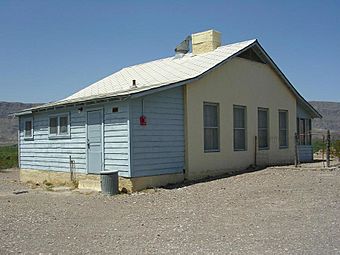Castolon facts for kids
Quick facts for kids |
|
|
Castolon Historic District
|
|

Army Officers' Quarters, Castolon
|
|
| Location | Along Rio Grande at jct. of Park Rtes. 5, 9, and 35, Big Bend National Park, Texas |
|---|---|
| Area | 800 acres (320 ha) |
| NRHP reference No. | 74000276 |
| Added to NRHP | September 6, 1974 |
Castolon, also known as La Harmonia Ranch and Campo Santa Helena, was a small community in southwestern Texas, United States. It is located inside what is now Big Bend National Park, right along the Rio Grande river. The first person to settle here was Cipriano Hernandez in 1901. He started farming the land and built the original Castolon Store, which is now called the Alvino House.
Contents
A Look Back at Castolon's Story
Early Days and the Mexican Revolution
The Castolon area started to attract people from nearby Mexico who were escaping the Mexican Revolution of 1910. This was a big conflict that caused many people to leave their homes. The U.S. Army set up a camp in Castolon, called Campo Santa Helena. Its job was to house soldiers who were patrolling the border between Mexico and the United States.
However, by the time the camp was finished in 1920, the border area had become peaceful. Because of this, the Army buildings were never actually used by soldiers.
The La Harmonia Company
In 1921, a company called La Harmonia was started in the old Army barracks. This company ran a trading post, which was like a general store where people could buy and sell goods. They also farmed cotton in the area.
Howard Perry, who owned another company nearby, started La Harmonia in 1918 with his partner Wayne Cartledge. Cartledge and his son Eugene managed the company. The La Harmonia Company operated for many years, until 1961. That's when it was sold to the National Park Service.
The 2019 Fire
On May 22, 2019, a fire that had started in Mexico the day before crossed the Rio Grande. The weather was very hot, around 110 degrees Fahrenheit (43 degrees Celsius), and there were strong winds. This made the fire spread very quickly.
Suddenly, the wind changed direction and blew strong gusts. These gusts carried burning embers across the Castolon Historic District. The embers landed on the latrine building and the barracks. The barracks building was especially important because it housed the La Harmonia Store and the Visitor Center. Both buildings were badly damaged by the fire.
What Castolon Looks Like
Castolon is divided into two main parts. The first part is called "Old Castolon." This area includes the original Old Castolon Store, a building that was both a cafe and a home, and a shed.
The second part is the "Army Compound." This area has several buildings:
- A barracks building, which is now the Castolon Store.
- A recreation hall, where people could relax.
- A latrine (a restroom building).
- Two homes for Army officers.
- A granary (a building for storing grain) and a tack room (for horse riding gear).
- Several other homes, including the Magdalena, Garlick, and Alvino residences.
The Magdalena and Garlick houses were built after the Army camp. They are connected to the La Harmonia Ranch. The Alvino house is the oldest, built even before the Army arrived.
All of the buildings in Castolon are made with adobe walls. Adobe is a natural building material made from earth, water, and straw. Most of the roofs are made of corrugated metal. Some buildings still have traditional roofs made with vigas (wooden beams), latillas (small wooden poles), and a layer of soil on top.
Castolon was recognized as an important historical place on September 6, 1974. It was added to the National Register of Historic Places.
Castolon's Weather
Castolon is located at coordinates 29°08′04″N 103°30′54″W / 29.13444°N 103.515°W. It sits at an elevation of about 2,169 feet (661 m) above sea level. The area generally experiences very hot summers and mild winters.



